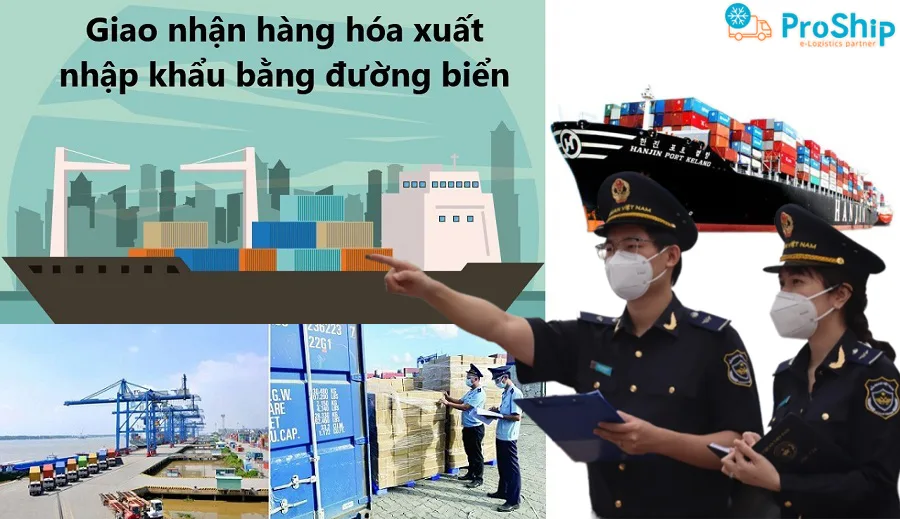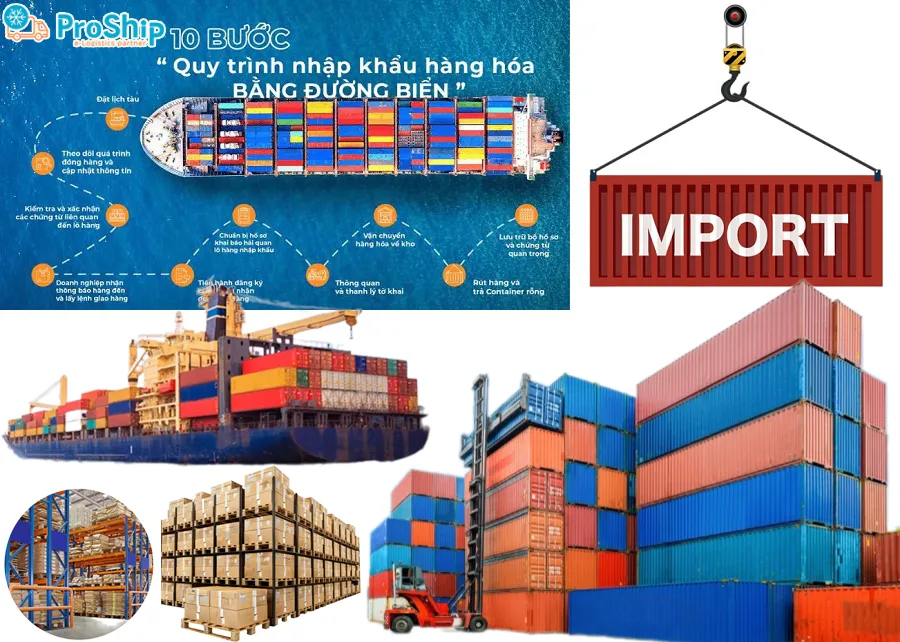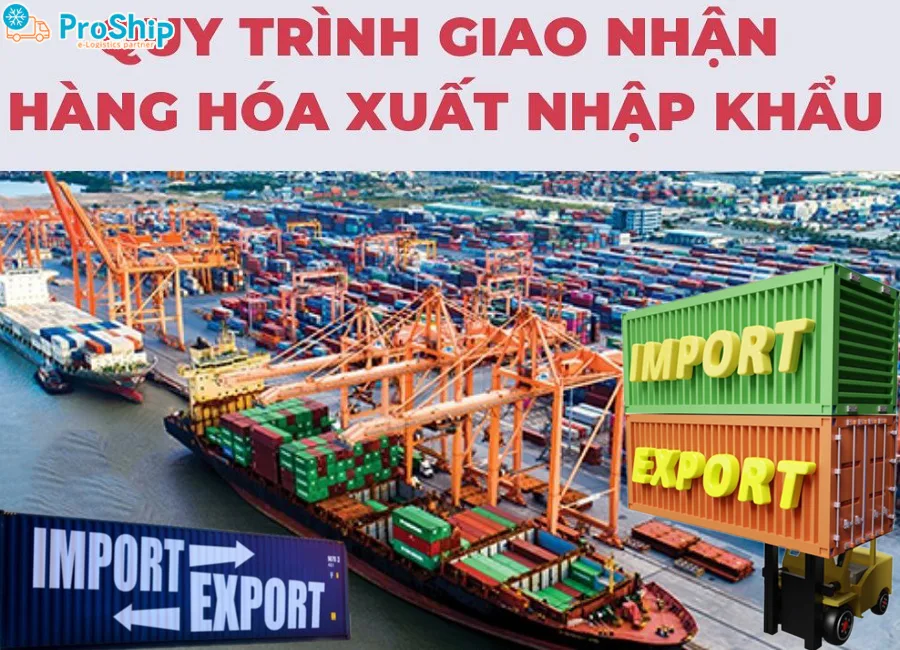x How do shippers and businesses importing goods by sea want to track the steps of delivery and receipt of imported goods by sea?
x Do you want to understand clearly what the concept of ocean import freight forwarding is? How long does delivery take?
x Do you want to know if there is anything you need to pay attention to when delivering import and export goods?
at Proship.vn will quickly update the process of delivering imported goods by sea so that shippers and import-export businesses understand every step before delivering goods to the recipient.
What is import and export freight forwarding by sea?
Forwarding import and export goods is a commercial act, the freight forwarder will be responsible for receiving goods from the sender, organizing transportation, warehousing, storage and providing other related procedural services to Deliver the goods to the recipient as designated by the customer, carrier or other forwarder.

Delivery of imported goods by sea is carried out by the port based on the contract between the goods owner and the person the goods owner entrusts. The loading and unloading of goods is arranged by the port. If the enterprise wants to put the vehicle in for loading and unloading, it must notify the port and pay the relevant fees.
For short routes, sea transport time is from 2 to 7 days. For longer routes, transport time will last from 12 to 45 days.
Process of delivering and importing goods by sea 2024
To carry out a process of delivering imported goods by sea, many steps will be needed. But to visualize general process of delivering FCL and LCL container shipping
Step 1: Set train schedule
After successfully signing a foreign trade contract, the business will proceed with ship booking. Businesses need to provide information to the shipping unit, who will then contact the supplier to cooperate in packing the goods. To book a ship, businesses need to provide information such as:
- Port of departure (port of loading);
- Transshipment port;
- Port of discharge;
- Product name, weight;
- Train time (ETD);
- Packing time;
- Some other information (container type, size, temperature,...).
Step 2: Monitor the packing process and update information
The forwarder and production unit are responsible for supervising and monitoring the goods packaging process. The information will then be updated to businesses and partners, including images that are packaged, stored safely, and are not damaged.
Step 3: Check and confirm documents related to the shipment
Businesses need to check and confirm documents and records related to the shipment to avoid errors and ensure the information provided is accurate. This step is very important because if an error occurs, the business will encounter many problems from customs, causing the import process to be interrupted, consuming a lot of time and effort.
Step 4: The business receives notification of goods arrival and receives a delivery order
Arrival notice is a notice of the estimated arrival time of the shipment sent from the shipping line or agent to the business. Businesses will receive notification of goods arrival 1 day before the ship arrives. Then businesses will need to prepare the following documents to proceed with receiving delivery orders (D/O):
- Referral;
- Original bill of lading;
- Power of attorney (if required).
Step 5: Proceed to register certifications for the shipment
Depending on the type of product and different HS codes, businesses will register for Food Safety Certificates, quarantine, quality inspection, etc. according to the regulations of the responsible State Agencies.
Step 6: Prepare customs declaration documents for imported goods
Enterprises need to prepare a set of customs documents including the following documents:
- Commercial Invoice – Commercial Invoice;
- Bill of Lading – Bill of Lading;
- Packing List - Packing List;
- Certificate of Origin - C/O (If any);
- Other documents depending on imported goods.

Step 7: Customs clearance and liquidation of declaration
Imported goods will be classified into channels and will have different customs processes:
- Green channel: Businesses will only need to pay taxes, liquidate declarations and receive goods;
- Golden stream: Enterprises need to pay taxes, complete procedures to open declarations, open declarations, then liquidate and receive goods;
- Red channel: Procedures will be similar to yellow channel, however, in the step of opening the declaration, it will be necessary to carry out procedures to check the actual quality of goods.
After completing the tax payment and the declaration is cleared, businesses need to submit 2 sets including the previously printed barcode and the cleared declaration to the customs. Customs will stamp one set and return one set to the business. After that, the business submits a set of stamped documents to the warehouse to have the goods shipped out.
Step 8: Transport goods to warehouse
To warehouse and transport goods to the warehouse, businesses need to go to the port's commercial office and bring a delivery order (D/O) to pay fees. Then give the driver documents such as: EIR slip, D/O,... to be licensed to transport goods to the warehouse.
Step 9: Withdraw and return empty container
After transporting goods to the warehouse, businesses need to carefully check the condition of containers, seals, trucks, etc. then withdraw the goods and return the containers to the port.
Step 10: Store important records and documents
Enterprises need to retain records and documents after importing goods in cases where goods problems, complaints, etc. arise to ensure rights and avoid loss.
>>See more: Process of exporting processed garments
When delivering import and export goods by sea, what should you pay attention to?
Proship Logistics has shared details of the import delivery process for businesses to understand. Next are the things you NEED TO KNOW when delivering imported goods by sea:
Note when delivering imported goods
With imported goods, when delivering and receiving, NOTE:
- Check goods information and package number when receiving goods to avoid lost goods;
- Monitor and update information from exporters to grasp the progress of shipments;
- Pay attention to the expiration date of the digital signature to ensure the declaration is transmitted to the system.

Note when delivering export goods
For exported goods, when delivering and receiving, NOTE:
- When receiving an empty container, it is necessary to check the type of container, the status of the empty container, the number of empty containers, and the number of seals before packing;
- For LCL (Less than Container Load) retail goods, you need to pay attention to checking the correct number of packages before carrying out warehousing procedures. After being warehoused, odd shipments will be arranged into containers with the same train;
- Submit SI and VGM before the Closing time shown on the booking.
We at Proship Logistics have shared the process of import and forwarding goods as well as the concept of forwarding imported goods by sea, what to pay attention to when delivering import and export goods by sea, etc. Businesses and shippers If you are interested, please consult and read any related questions, contact immediately 0909 344 247 for dedicated answers.
Maybe you are interested:
